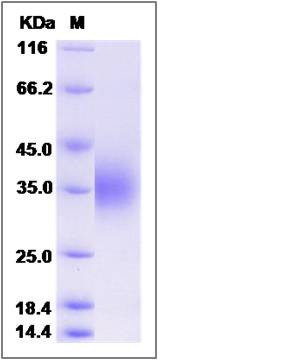Rat Epcr / PROCR Protein (His Tag)
PROCR
- 100ug (NPP3099) Please inquiry
| Catalog Number | P80362-R08H |
|---|---|
| Organism Species | Rat |
| Host | Human Cells |
| Synonyms | PROCR |
| Molecular Weight | The recombinant rat PROCR comprises 204 amino acids and predicts a molecular mass of 23.2 kDa. The apparent molecular mass of the recombinant protein is approximately 33-37 kDa in SDS-PAGE under reducing conditions due to glycosylation. |
| predicted N | Asn 21 |
| SDS-PAGE |  |
| Purity | > 95 % as determined by SDS-PAGE |
| Protein Construction | A DNA sequence encoding the rat PROCR (Met1-Ser213) was expressed with a polyhistidine tag at the C-terminus. |
| Bio-activity | |
| Research Area | Immunology |Innate Immunity |Coagulation |Coagulation Cascade |
| Formulation | Lyophilized from sterile PBS, pH 7.4 1. Normally 5 % - 8 % trehalose and mannitol are added as protectants before lyophilization. Specific concentrations are included in the hardcopy of COA. |
| Background | Endothelial protein C receptor (EPCR), also known as activated protein C receptor (APC receptor) or PROCR, is a receptor for Protein C. Protein C plays an important role in many metabolism processes in humans and other animals after activated by binding to Endothelial protein C receptor (EPCR). Because of the EPCR is found primarily on endothelial cells (cells on the inside of blood vessels), activated protein C is found maily near endothelial cells. Protein C is pleiotropic, with two main functions: anticoagulation and cytoprotection. Which function will be performed depend on whether or not protein C remains bind to EPCR after activated. The anticoagulation occurs when it does not. In this case, protein C functions as an anticoagulant by irreversibly proteolytically inactivating Factor Va and Factor VIIIa, turning them into Factor Vi and Factor VIIIi respectively. When still bound to EPCR, activated protein C performs its cytoprotective effects, acting on the effector substrate PAR-1, protease-activated receptor-1. To a degree, APC's anticoagulant properties are independent of its cytoprotective ones, in that expression of one pathway is not affected by the existence of the other. |
| Reference |
